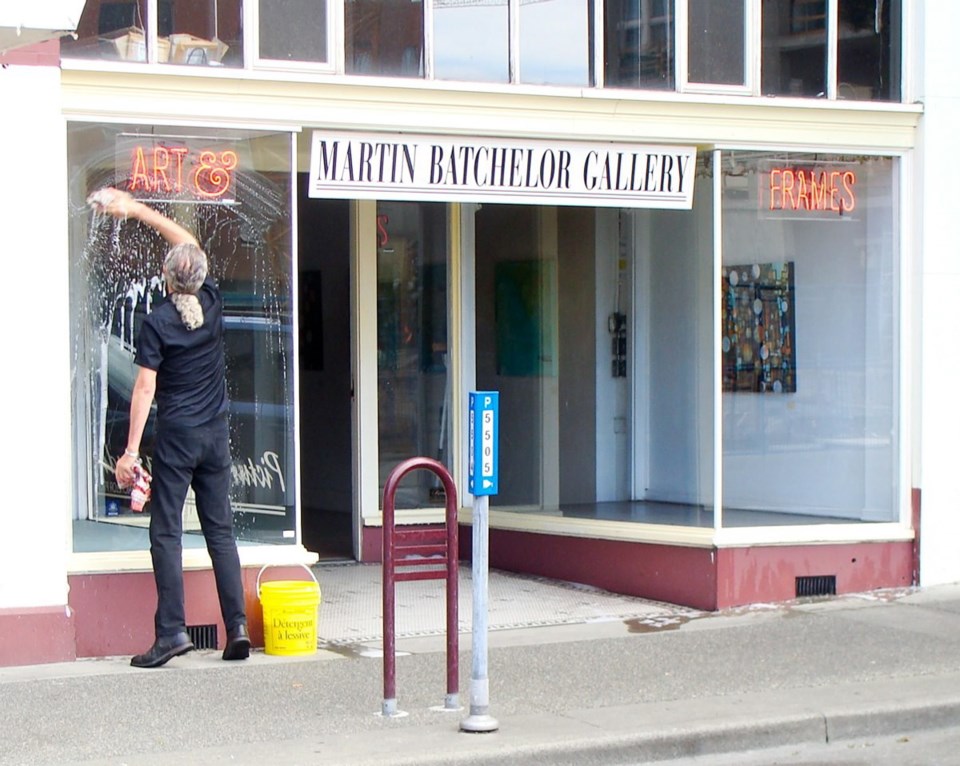Saturday morning, 10 a.m. It’s opening time at the Martin Batchelor Gallery, and Martin is out front washing the windows. After I chain my bike up on the sidewalk, he and I stand out in the sunshine and talk things over. The little shop at 712 Cormorant St. was the Barton-Leier Gallery before he took it over 20 years ago, and at the moment the area is undergoing a lot of changes.
Down by the corner of Douglas Street and Cormorant, a two-panel mural painting by Ken Faulks graces an otherwise blank wall, and the sidewalk by the gallery is bathed in the exhaust from a medical-marijuana club. You can’t miss the ongoing construction right across Cormorant Street from the gallery. They’ve opened a huge abyss — four storeys deep — for a foundation, which has opened sightlines that we haven’t seen before. Ignoring the dust, Batchelor and I gazed across to a building on the south side of Pandora Street.
723-725 Pandora is known as the Maynard Block. It was purpose-built in 1891 by Richard Maynard and his wife, Hannah. They had a shoe store in the ground floor and a photography studio upstairs. You can recognize the studio by its two huge north-facing windows — just what an artist requires. Hannah Maynard was the photographer, and her multiple-exposure photomontages earned her a place as one of sa���ʴ�ý’s first surrealists. John’s Place Restaurant operates out of what was originally the shoe store. The studio upstairs is now Eric Barker’s architectural office, and has been a productive home for many Victoria artists, including Glenn Howarth, Jim Lindsay and Jack Wise.
To the east of the Martin Batchelor Gallery, the Richard Blanshard Building on 1515 Blanshard St. houses the provincial Ministry of Health. When it was opened in the 1970s, it was graced with public art by Jack Kidder and Carole Sabiston. Joseph Caveno’s delicate steel mobile hung over the entrance hall, and Margaret Peterson created a large mural of Italian mosaic tiles. It expresses her interest in primitive art, and the techniques and materials she had learne in Ravenna, Italy. The mural is still there, but the building is not really open to the public.
To the west of Martin Batchelor Gallery is Victoria City Hall, constructed in 1878 to a design by John Teague. Teague also designed the Masonic building at Douglas and Fisgard streets in the same year — the designs are similar. Our City Hall is a grand building, with a well-proportioned façade and bell tower. Its dignity was not at all compromised by the Centennial Square development of the 1960s. Since the recent demolition of City Hall News and a bank, the City Hall’s Douglas Street streetscape can be seen from some distance. This temporary civic square will be gone when the west half of the new building goes up.
Inside City Hall, I enjoyed a modest display of 10 photos and additional material from the Victoria City Archives, showing fine homes in Victoria that no longer stand. One is a gracious home designed by John Teague that once stood at Caledonia and Cook streets.
As Martin soaped and squeegeed his shop windows, he was his usual calm self. He invited me in to see the six-person show on display, and gave me an invitation for Wendy Skog’s exhibit opening Sept. 10. This marks 20 years Skog has exhibited here. Unlike most galleries, which keep a stable of artists under exclusive contract, Batchelor essentially rents his space to exhibitors, leaving them to do the public relations. He’s generally busy with his picture framing business at the back of the store.
Martin asked if I’d seen the Lincoln Clarkes photo exhibit at Polychrome Fine Art (977-a Fort Street, until Aug. 18). There are 64 photos by Clarkes, taken over the course of his long career as a street photographer and man-on-the-scene in Vancouver. Included are images from Heroines, his famous document of women who take drugs, and I saw a copy of his more recent book Cyclists. This one presents young and obviously empowered women, their hair blowing in the breeze as they forge ahead through city traffic on bicycles. Photographically, Clarkes sets out to be Weegee, Helmut Newton and Fred Herzog all at once, and often succeeds.
As I made my way home from the Martin Batchelor Gallery, I rode past tent city to see how the cleanup was going. To my surprise and delight, the Raven Baroque orchestra had set up their own tents across the street on the grounds of Christ Church Cathedral. There, under the oaks, nine men and women — in wigs and period costumes — offered a long program of sublime music for strings and flute. The shapely tones of Pergolesi’s Flute Concerto in F (soloist Lana Betts) in their unamplified state floated out on the warm summer morning.
This bit of performance art provided an inspiring contrast to what was going on over at the courthouse lawn. Art doesn’t just hang on a gallery wall. It could be architecture, or installation, or performance. But when it’s art, you’ll know by the inspiration you feel.



